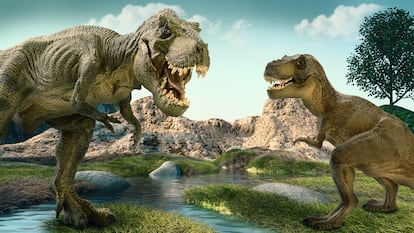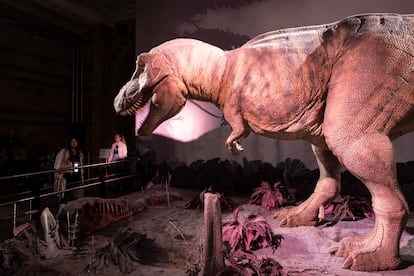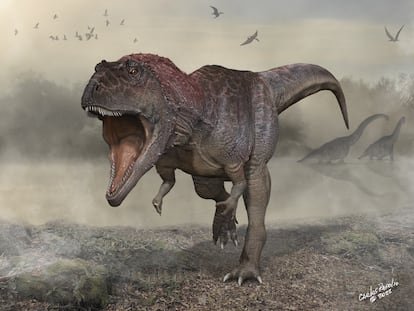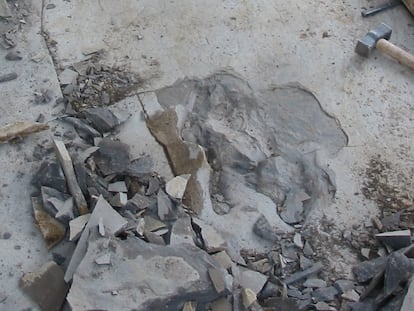Why did ‘T. rex’ have such tiny arms?
There are many hypotheses, from mating to avoiding the risk of being bitten, that may explain why the famous dinosaur had such ridiculously small forelimbs

Evolution is a constant loss. The whole idea that progress is made from the simple to the complex is incorrect. The path of progress is exactly the opposite; the future is simple. At least when nature is making the decisions. So believe the paleontologists who are trying to understand why one of the largest predators in history, the famous Tyrannosaurus rex, popularly known as T. rex, had such tiny arms.
But T. rex wasn’t the only dinosaur with tiny arms; all theropods shared this feature. Not only were their arms consistently short, but they were increasingly so throughout evolution and in all species of the group, independently. It is as if in all cases, the genes of those bestial bipedal bodies had come to the same conclusion on their own. So, what was the purpose of the mini-arms? There are at least six possible answers.
So that other dinosaurs would not bite them
This year, paleontologist Kevin Padian from the University of California published a possible explanation in the journal Acta Palaeontologica Polonica. “The forelimbs became shorter in the context of behavioral ecology: the great skull and jaws provided all the necessary predatory mechanisms, and during group-feeding on carcasses, limb reduction was selected to keep the forelimbs out of the way of the jaws of large conspecific predators, avoiding injury, loss of blood, amputation, infection, and death,” he summarizes in his article. However, behavior is one of the most difficult aspects to figure out from something as inert as a fossil.
Thomas Holtz, an American paleontologist at the University of Maryland and an expert on North American giant carnivores, thinks there are holes in Padian’s theory. After all, he ponders, even if the arms of the Tyrannosaurus and other giant theropods could accidentally have been bitten if many individuals were feeding at once, it probably did not occur often enough for selective pressure to reduce the size of their arms.
Not that it was much of a feast, too. The prey they could eat in what is now the United States was not big enough to share. “We have no evidence that Tyrannosaurs ate together. We’d need to see the prey they had, how much could be eaten from it. It’s not that they hunted large sauropods, because at the time – and place – they lived there weren’t critters that weighed dozens of tons. In fact, the Tyrannosaurs’ preys were probably smaller than them,” says Juan Canale, a paleontologist from the Argentine Patagonia and a researcher at the National Council for Scientific and Technical Research of Argentina (CONICET).

Italian-Argentinean paleontologist Damiano Palombi, an intern at the same institution, is also unconvinced by Padian’s hypothesis. “As humans and as paleontologists, we try to find a reason for everything, but in the end it’s not always like that.” According to him, organisms are selected as a whole and not by elements, where each one has a function. In other words, evolution is integral, which sometimes can entail the detriment of one characteristic in favor of another. Palombi believes that, for example, to enhance predation, the evolutionary energy was focused on the jaw and the skull, and the arms were simply less important.
In any case, the function is a consequence of the adaptation to the change. We do what we can with what evolution makes of us. “I could say that my hands are perfect for typing on a keyboard, but they were not selected for that, but for other functions that are perhaps related to my arm, and that led to my hand having its current characteristics,” explains Palombi. “Some organs lose a function, or change it, and we can’t always see the process. Actually, we never get to see it. We only know the final result,” he concludes.
A matter of age
One of the strongest theories has to do with allometric growth, that is, the uneven development of an animal’s organs or body parts. This hypothesis posits that dinosaur arms may not always have been so ridiculously small. Canale favors this idea. “Perhaps the young ones, who had longer arms, would find them more useful for hunting. Tyrannosaurs, for example, are a group that grew very quickly during the first years of life. Surely one that’s young, a couple of meters long and a few hundred kilos in weight, would not feed in the same way as a critter that’s over 10 meters long and weighs eight tons. It would have had different hunting or feeding methods. The slightly more developed arms in the juvenile forms probably would have been more useful.”
That uneven rhythm of growth is familiar to us. “It is very common in all vertebrates. Not so in insects, in which growth is isometric. A small insect compared to a larger one is equal in proportion. The whole body grows evenly. This is not the case in humans. Babies have big heads; the head is almost half of the body. And in the course of ontogenesis, in the development of growth, it grows much less, proportionally, than the rest of the body,” says Canale. When there are no specimens of each stage to contrast, researchers can only speculate. This is the case with many dinosaurs, such as the theropod Giganotosaurus carolinii; only two of them are known, and one is just a piece of jaw. However, this is not the case with the T. rex, which Holtz knows in detail. He fully agrees with Canale and Palombi. “With the Tyrannosaurus rex, a young individual has a humerus [upper arm bone] that is 40% of the length of the femur [thigh bone]; while in an adult it is less than 30%. So, the arms become progressively useless with a larger body. At the same time, the size and strength of the skull become much more powerful. So the youngest giant theropods could have grasped food with their arms, but they became basically useless when they were fully grown.”

The Argentines support this idea. “The short arms of the Tyrannosaurus have to do with allometric growth. Thomas Holtz said it. The adult hunted other things and had as its main weapon the giant skull, which was huge in relation to the rest of the body, armed with very large teeth, with a very high capacity and bite force, so the arms were not necessary,” says Canal.
A riddle wrapped in speculation
The other four theories do not have many followers. One of the first was related to mating and was established in 1906 by Henry Osborn, the person who named the T. rex. He thought that those little arms with powerful shoulder insertions could have served as handles to hold a partner during copulation, but nobody believes this anymore.
A slightly more daring idea suggests sexual display. For that, we have to imagine a T. rex with feathers, waving its little arms in circles. Picture a dancing, feathered king-lizard-tyrant – an image that further damages his fading reputation as a bloodthirsty villain. Palombi thinks this idea is interesting because “it fits in with the idea that the Tyrannosaurus was covered in plumage, which could have been useful both for reproduction and for other behavioral interactions.” However, he admits that there is little point in trying to attract someone’s attention with an insignificant resource. Canale shares his doubts. “Generally, the attributes meant to attract the opposite sex are things that are exaggerated, not diminished.”
Another idea states that the arms could have served to push and lift the body from the ground, as if standing up after a nap. Palombi has a hard time picturing it. “It seems very strange to me, to try to lift five tons of theropod with the arms, without thinking that the legs were much more functional.” The theory was established based on Tyrannosaurus tracks that some researchers interpreted as the marks of a dinosaur trying to get up. “I think that for animals like this, due to the configuration of their necks and vertebrae, it was more useful to arch their necks and push their legs to get up. Because the muscles of the back were extremely developed,” explains Palombi. “Does someone who has a very well-trained back, like a swimmer, try to get up with their pinkies?”
Finally, it is possible that the strange little arms of the theropods were absolutely useless. Without similar animals in the present, the scientific imagination sometimes finds itself at a dead end. “In addition to how difficult it is to know precisely the purpose of the arms, we do not have current parallels: there is no bipedal, carnivorous animal, of great size, with a proportionally very large head with respect to the body and tiny arms,” Canal explains. “The arms may seem like something vestigial or something that remained there with no purpose, although I think that the theory that they were useless has already been ruled out.” Because, although the arms were short, the bones were robust, the muscle insertion was solid and the union of the limb with the thorax, enormous. “It’s hard to think that all that was there not to be used. It had some kind of usefulness, I’m sure. The question is: what?” asks the paleontologist. The answer remains shrouded in mystery.
Tu suscripción se está usando en otro dispositivo
¿Quieres añadir otro usuario a tu suscripción?
Si continúas leyendo en este dispositivo, no se podrá leer en el otro.
FlechaTu suscripción se está usando en otro dispositivo y solo puedes acceder a EL PAÍS desde un dispositivo a la vez.
Si quieres compartir tu cuenta, cambia tu suscripción a la modalidad Premium, así podrás añadir otro usuario. Cada uno accederá con su propia cuenta de email, lo que os permitirá personalizar vuestra experiencia en EL PAÍS.
¿Tienes una suscripción de empresa? Accede aquí para contratar más cuentas.
En el caso de no saber quién está usando tu cuenta, te recomendamos cambiar tu contraseña aquí.
Si decides continuar compartiendo tu cuenta, este mensaje se mostrará en tu dispositivo y en el de la otra persona que está usando tu cuenta de forma indefinida, afectando a tu experiencia de lectura. Puedes consultar aquí los términos y condiciones de la suscripción digital.
More information
Últimas noticias
All the effects of gentrification in one corner of Mexico’s Colonia Roma
Palestinian reporter Youmna El Sayed: ‘My family told me I had to choose between being a journalist or a mother’
The new language of the workplace: Knowing how to ask AI questions is more important than using it
Merz tries to replace Macron at the helm of Europe
Most viewed
- Christian Louboutin: ‘Young people don’t want to be like their parents. And if their parents wear sneakers, they’re going to look for something else’
- The low-cost creative revolution: How technology is making art accessible to everyone
- US sanctions against jailed cartel leader ‘El Marro’ highlight Mexico’s lack of control over its prisons
- Liset Menéndez de la Prida, neuroscientist: ‘It’s not normal to constantly seek pleasure; it’s important to be bored, to be calm’
- Cartels in Mexico take a leap forward with narco-drones: ‘It is criminal groups that are leading the innovation race’










































